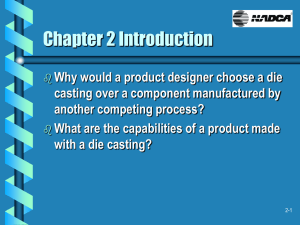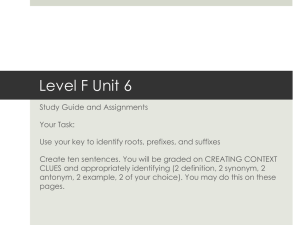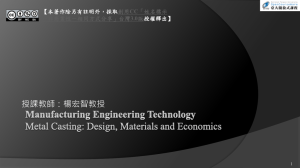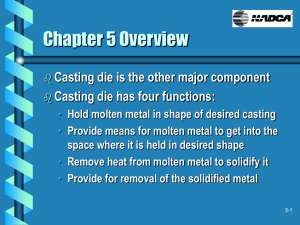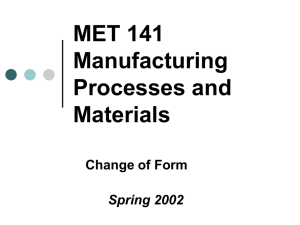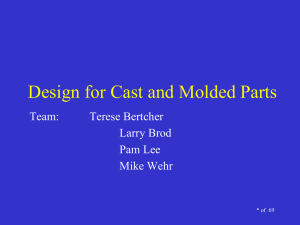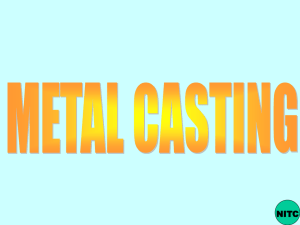Introduction To Die Casting - North American Casting Corporation
advertisement
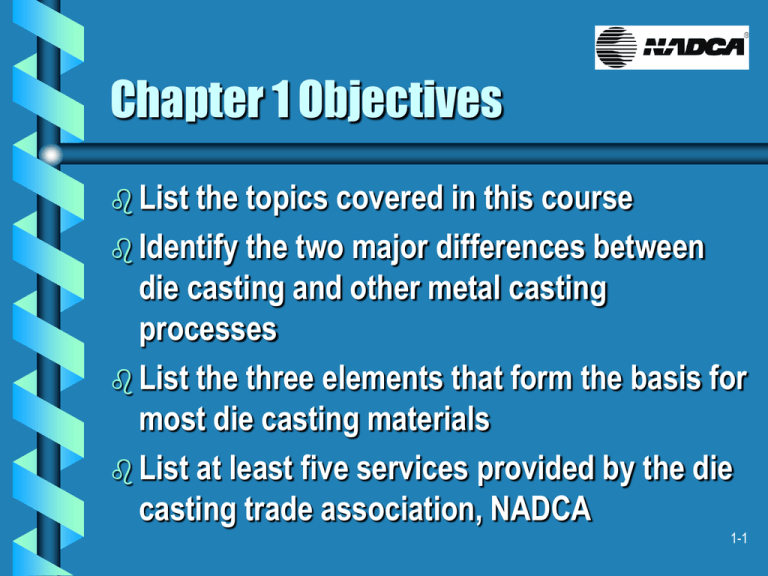
Chapter 1 Objectives List the topics covered in this course Identify the two major differences between die casting and other metal casting processes List the three elements that form the basis for most die casting materials List at least five services provided by the die casting trade association, NADCA 1-1 New Term Metalcasting • The industry of pouring liquid metal into a mold to achieve a desired shape. 1-2 Metal Casting History An • • • • • ancient industry: Sand casting Investment casting Lost foam casting Permanent mold casting Centrifugal casting All foundry processes 1-3 Die Casting vs Foundry Process Die casting is a variation of metalcasting Liquid metal injected into reusable steel mold, or die, very quickly with high pressures Reusable steel tooling and injection of liquid metal with high pressures differentiates die casting from other metalcasting processes 1-4 Sand, Investment, and Lost Foam Casting Use gravity to fill the mold Mold is destroyed to remove casting Metal flow is slow Walls are much thicker than in die casting Cycle time is longer than die casting because of inability of mold material to remove heat 1-5 Permanent Mold Casting Cousin to die casting Mold removed, not destroyed Uses gravity to fill mold Metal flow is slow Mold is steel - has comparatively good thermal conductivity Machines smaller 1-6 Centifugal Casting Frequently made by jewelers The choice for low volume castings with a small amount of pressure Molds are placed around the circumference of a centrifuge • As centrifuge spins, metal poured in at center and centrifugal force distributes metal to the molds 1-7 Die Casting History Begun during middle of 19th century In 1849, 1st machine for casting printing type 20 years before began casting other shapes Linotype machine direct result of the casting of printer’s type 1892 - parts for phonographs, cash registers 1900’S - babitt alloy bearings produced 1-8 History of Casting Alloys Various compositions of tin and lead were the first die casting alloys Development of zinc alloys just prior to World War I caused decline of tin and lead Magnesium and copper used next 1930s-many of today’s alloys developed Still making refinements resulting in new alloys with increased strength and stability 1-9 Process Improvements To die steels To die construction In casting capability In production capacity of the process 1-10 Current Industry - 1995 Figures Approximately 450 die casters in North America with sales of $8 billion Die castings produced from aluminum, copper, lead, magnesium and zinc alloys as well as various composite materials The top three alloys were: • Aluminum • Zinc • Magnesium 1-11 Current Use of Castings Cars Appliances Office equipment Sporting goods Machinery Toys Many other applications 1-12 Types of Casting Operations “Captive” die caster • Produces die castings for their own use, for example, General Motors “Custom” die caster • Produce castings for customers’ use • Typically only manufacture for other companies, not themselves 1-13 North American Die Casting Association (NADCA) North American trade association is NADCA Mission is to be the worldwide leader of and resource for stimulating continuous improvement in the die casting industry Provides services to its members 1-14 R&D of New Materials and Technologies Die casting alloy performance Die life Process capability Process simulation Energy conservation Environmental management/pollution prevention Rapid tooling 1-15 Education and training At Chicago headquarters At local chapters In-plant Through Learn@Home courses “Education for the Die Casting Industry” 1-16 Government Relations, Safety, and Awards Source for federal govt. relations activity Speak with single voice in Washington, D.C. • $5.8 million in DOE research dollars in 1998 Recognizes outstanding safety records Annual Awards to distinguished members Annual scholarships awarded 1-17 Marketing Statistics and Surveys End Markets for Die Castings Financial Survey Die Cast Machine Study 1-18 Meeting. Conferences, and Exposition International Congress and Exposition held every two years Other conferences and meetings, including: • • • • • Plant Management Conference Government Affairs Briefing Die Materials Conference Computer Modeling Technology Workshops 1-19 Other Services Die Casting Engineer Magazine Publications, software and video Diecasting Development Council NADCA website at www.diecasting.org 1-20 Summary Die casting began in the 19th century Castings today: • Top alloys-aluminum, zinc, magnesium • Used in a wide variety of items • Produced by captive or custom die casters NADCA, is the trade association representing the industry • Provides many services to the industry 1-21

